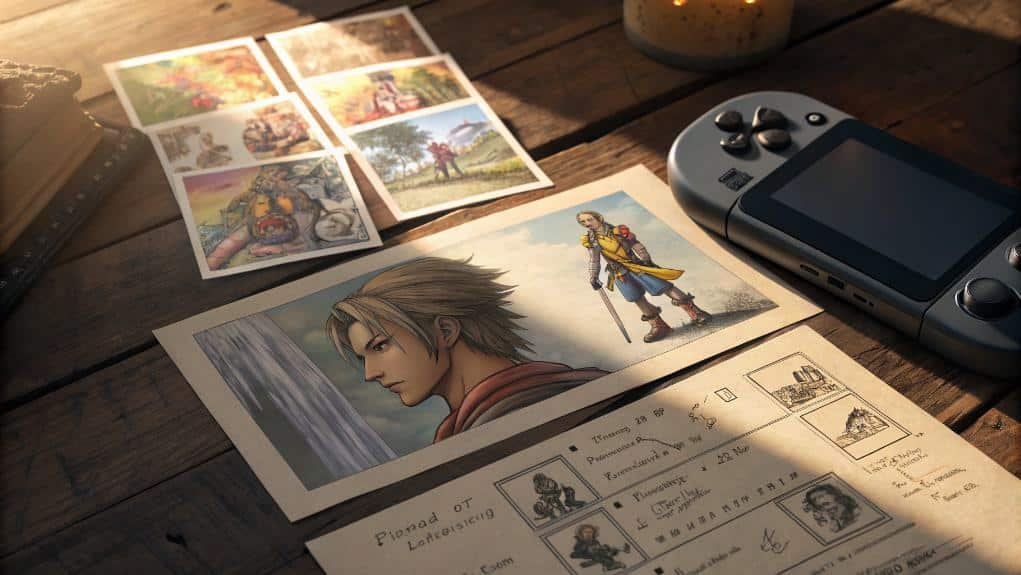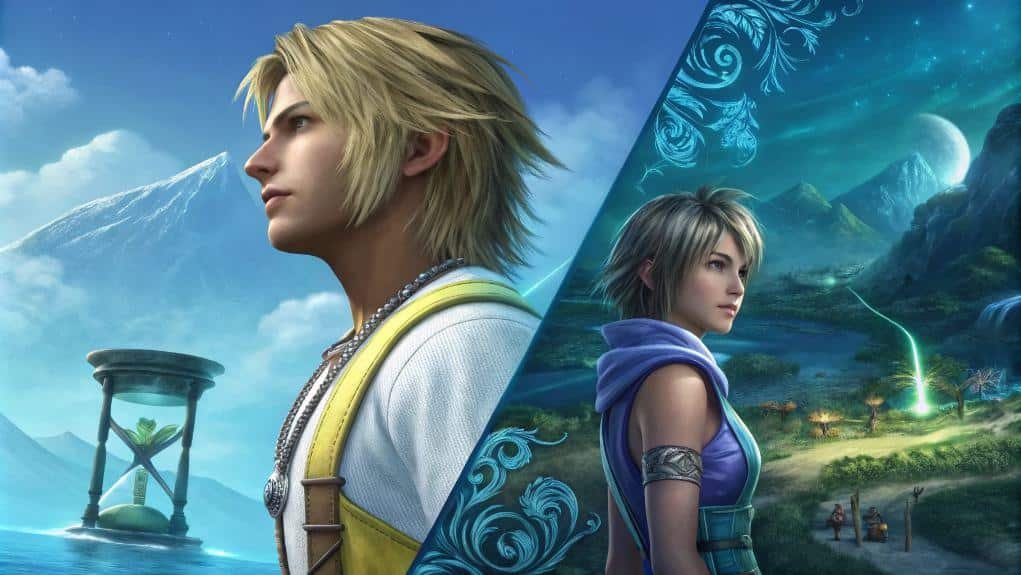Final Fantasy X launched in 2001, marking a pivotal moment in RPG history with its ambitious development and storytelling depth. It introduced players to the richly crafted world of Spira, where protagonist Tidus and summoner Yuna confront themes of sacrifice and redemption. The game innovated with a turn-based combat system and the unique Sphere Grid for character customization, enhancing player engagement. Culturally inspired by Southeast Asian elements, its narrative and characters resonated deeply, achieving over 8 million sales. Its legacy continues through the HD remaster and sequels, suggesting a lasting impact on both fans and the gaming landscape that still unfolds today.
Key Takeaways
- *Final Fantasy X* was developed starting in 1999 and released in 2001 for PlayStation 2, achieving over 8 million copies sold.
- The game features a narrative centered around Tidus and Yuna, exploring themes of sacrifice, redemption, and the cyclical nature of violence.
- It introduced innovative gameplay mechanics, including the Conditional Turn-Based Battle system and the Sphere Grid for character customization.
- The game's cultural influences are drawn from Southeast Asian architecture and mythology, enriching its lore and emotional storytelling.
- *Final Fantasy X* remains influential in the RPG genre, spawning a sequel, *Final Fantasy X-2*, and ongoing discussions about potential future installments.
Development Timeline

When tracing the development timeline of Final Fantasy X, it's clear that its journey began in 1999, marking a pivotal shift in the franchise as it ventured into the sixth console generation with the PlayStation 2.
The development team, comprising over 100 individuals, faced significant development challenges. With a budget of approximately ¥4 billion, or $32.3 million, the stakes were high. Over 8 million copies sold on PS2 highlight the game's success and its impact on the series.
Under the leadership of producer and director Yoshinori Kitase, the team had to navigate the complexities of creating a groundbreaking title. The dynamics among key contributors like scenario writer Kazushige Nojima and character designer Tetsuya Nomura played an essential role in shaping the game's vision.
Their collaboration fostered innovation, leading to the introduction of voice acting, a first for the series, and the revolutionary Conditional Turn-Based Battle system.
The integration of fully 3D environments also marked a departure from previous titles, showcasing the team's ambition.
Despite the hurdles, the collective effort and synergy within the team resulted in a landmark game that would redefine the franchise and leave a lasting impact on the gaming industry.
Story Overview
Final Fantasy X presents a rich narrative that intertwines personal journeys with larger themes of sacrifice and redemption. The story begins in the technologically advanced city of Zanarkand, which is obliterated by the monstrous entity known as Sin. Tidus, the protagonist, finds himself transported to Spira, a world in stark contrast to his own. His emotional journey intertwines with Yuna, a young summoner on a pilgrimage to defeat Sin, establishing complex character dynamics that drive the plot progression.
As the party travels through Spira, they confront moral dilemmas, including the cyclical nature of violence and the sacrifices required of summoners. Each character arc deepens the thematic depth, particularly through Auron's guidance and Seymour's betrayal, which reveals the corruption within the Yevonite church. Tidus's role as a guardian for Yuna further emphasizes the importance of friendship and protection throughout their quest.
The narrative structure culminates in the discovery of Yu Yevon, the true source of Sin, leading to a climactic battle that breaks the cycle of rebirth.
Through its meticulous world-building and layered storytelling, Final Fantasy X invites players to ponder existential questions about identity and existence, all while showcasing the transformative power of friendship and love in overcoming adversity.
Gameplay Innovations

In an era defined by innovation in role-playing games, Final Fantasy X introduced groundbreaking gameplay mechanics that substantially reshaped the genre. The game replaced the traditional Active Time Battle (ATB) system with its Conditional Turn-Based (CTB) system, which allowed players to strategize more effectively by displaying a graphical timeline of turn orders. This shift in combat mechanics enabled players to plan their moves around not only their characters but also the enemies, adding depth to battles. Moreover, the introduction of the Sphere Grid transformed character customization. Instead of following a linear leveling system, players could manually navigate a grid to enhance character abilities and statistics. This system allowed for unique builds and strategic planning, though it became more restrictive as the game progressed. Additionally, the incorporation of Overdrives and the Aeon system provided further layers of tactical options, ensuring that combat remained dynamic and engaging. As a result, the ongoing evolution of gameplay mechanics not only distinguished Final Fantasy X from its predecessors but also set a new standard for character progression and battle strategy in the RPG genre.
Cultural Influences
Building on its innovative gameplay mechanics, Final Fantasy X also stands out for its rich cultural influences that shape both its world and narrative. The developers meticulously crafted Spira, integrating various elements that reflect a blend of Southeast Asian architecture and spiritual influences.
This unique setting is characterized by:
- Southeast Asian Architectural Influences: Structures like Besaid Temple and Kilika's stilt-houses draw inspiration from traditional Southeast Asian designs. The designs of structures in Spira evoke a sense of tropical paradise, reminiscent of Southeast Asian landscapes.
- Geographic Diversity: Spira's overall aesthetic embodies a fusion of South Pacific, Thai, and Japanese cultures, creating a vibrant tapestry.
- Religious Themes: The game explores oppressive religious beliefs, highlighting the struggle against dogma and the importance of understanding.
- Mythological Elements: Shoopufs and the Moonflow showcase mythological concepts rooted in Southeast Asian traditions, enriching the lore.
These cultural symbols and spiritual influences aren't mere decoration; they serve as narrative vehicles that explore themes of redemption and unity.
Reception and Impact

Upon its release, *Final Fantasy X* garnered widespread acclaim, setting a new standard for role-playing games in the early 2000s. The game achieved remarkable commercial success, selling over 6 million copies on the PlayStation 2 alone. Its engaging storyline, particularly the poignant love story between Tidus and Yuna, resonated deeply with fans, leading Square Enix to break tradition by releasing a direct sequel, *Final Fantasy X-2*. The strong character investment noted among fans contributed to the sales success of both titles.
| Aspect | Details |
|---|---|
| Initial Sales | Over 6 million copies sold |
| Total Series Sales | 21.1 million units worldwide |
| HD Remaster Sales | Nearly 7 million copies |
| Critical Reception | Praised for gameplay and music |
Critics praised the sequel for its innovative mechanics and multiple endings, enhancing replayability and keeping player interest alive. The soundtrack, composed by Noriko Matsueda and Takahito Eguchi, received accolades as well. The enduring success of both *Final Fantasy X* and *X-2* has set a benchmark for future titles within the franchise, influencing the direction of subsequent games and demonstrating a strong inclination for direct sequels in the series.
Legacy and Re-releases
*Final Fantasy X* has solidified its legacy not just through its original release but also via its subsequent re-releases, which have introduced the game to new generations of players.
The game's groundbreaking storytelling and character evolution have left an indelible mark on the RPG genre. Many players have reported being moved to tears by the game's ending, showcasing its emotional impact on the audience.
Key aspects of its legacy include:
- Groundbreaking Storytelling: Its deep narrative and emotional resonance have set new standards.
- Cultural Phenomenon: The game has inspired various art forms, including music and film.
- Enduring Popularity: Fans continue to celebrate and recommend it as a classic RPG.
- Iconic Status: It's frequently cited as one of the best entries in the Final Fantasy series.
The 2001 release for PlayStation 2 paved the way for later re-releases, like the *Final Fantasy X/X-2 HD Remaster*, ensuring its preservation.
This commitment to maintaining the original's integrity has allowed players to explore the world of Spira and its characters without the distraction of unnecessary sequels.
As a result, *Final Fantasy X* remains a benchmark for emotional storytelling and character development, influencing future titles in the franchise.
Sequels and Expansions

In the domain of gaming, few titles have expanded their narratives as considerably as *Final Fantasy X*, which not only introduced players to the world of Spira but also laid the groundwork for its first direct sequel, *Final Fantasy X-2*.
This sequel, set after the original game's conclusion, investigates deeper into character relationships, particularly between Tidus and Yuna, exploring themes of love, loss, and the quest for identity.
The *Final Fantasy X/X-2 HD Remaster* further enriches the narrative with the audio drama *Final Fantasy X -Will-* and the novel *Final Fantasy X-2.5 ~Eien no Daishō~*, both bridging gaps and introducing new characters. Additionally, the remaster includes a 30-minute episode that was not present in the original games, providing even more context to the storyline.
These expansions enhance narrative depth, weaving melancholy tones with open-ended conclusions that provoke player imagination.
While the success of *Final Fantasy X-2* marked a departure from series tradition, it set a precedent for potential future installments, including a possible *Final Fantasy X-3*.
Although development hinges on the completion of other projects, the prospect remains intriguing, promising to further explore the complex dynamics established in previous titles.
Lasting Influence on Gaming
The History of Final Fantasy X
Lasting Influence on Gaming
Few titles have left as profound a mark on the gaming landscape as *Final Fantasy X*, which not only revolutionized RPG mechanics but also set new standards for narrative depth. Its impact is evident in several key areas:
- Innovative Battle System: The shift to Conditional Turn-Based Battle (CTB) allowed players to strategize more effectively.
- Character Development: The game presented dramatic, believable character arcs that resonated emotionally, enchanting players. Additionally, the emotional depth of the characters contributed significantly to the game's lasting appeal.
- Emotional Storytelling: Engaging narratives fostered deep emotional connections between players and the characters, enhancing the gameplay experience.
- Cultural Significance: *Final Fantasy X* became a defining title for many gamers, influencing their expectations for future RPGs.
The game's focus on character progression and emotional growth transformed how developers approached storytelling in games. Players now expect intricate narratives that explore psychological depth, making character arcs more engaging.
Its memorable moments and high-quality audio-visual presentation set a new standard for the genre. As a result, *Final Fantasy X* not only shaped individual gaming experiences but also influenced the broader RPG landscape, ensuring its legacy endures long after its release.

